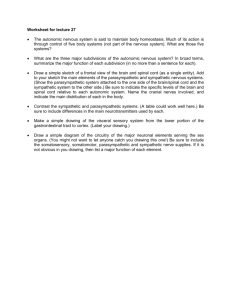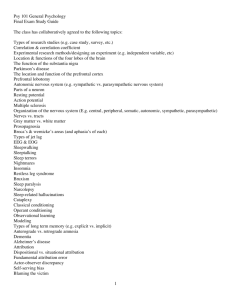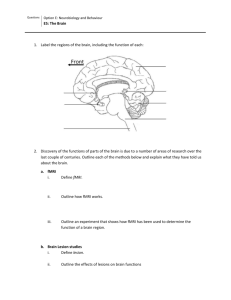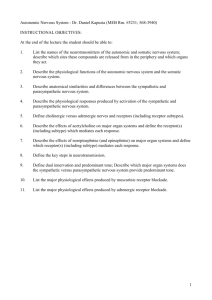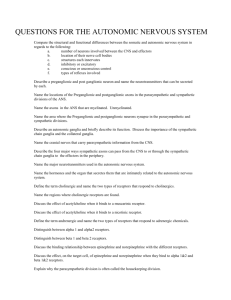Autonomic nervous system MGMC
advertisement
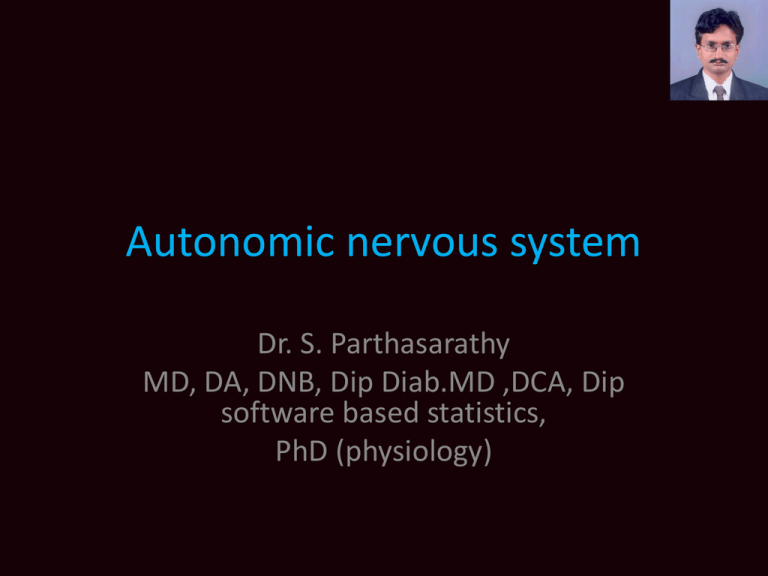
Autonomic nervous system Dr. S. Parthasarathy MD, DA, DNB, Dip Diab.MD ,DCA, Dip software based statistics, PhD (physiology) Definition • The autonomic nervous system (ANS) controls the body's involuntary (i.e.,outside of consciousness) activities. • Autonomic • the most primitive and among the most essential of the body's systems • Primitive – all mammals • Essential – most important systems History • Almost a century ago, in 1898 the autonomic nervous system was actually described first by Langley. • It was called at that time as the visceral, vegetative or involuntary nervous system • by meditation and yoga the HR, BP, visceral sensation, etc, which are controlled by the ANS can be modulated. Nervous system in simple terms Two systems • Sympathetic • Parasympathetic • Nerves are traditionally classified by the chemical transmitters that they contain. • Nerves containing acetylcholine are called cholinergic, • containing norepinephrine are called adrenergic. Structure • Autonomic sensory receptors • Sensory neuron • Integrating centres ( hypothalamus, cord, brainstem) • Motor -----• Effector Motor Structure • ANS is Reflex arc • Preganglionic –( CNS ) –axons – • synapse in ganglia --• postganglionic neurons --• effector organs Sympathetic Parasympathetic ACh Somatic .. ?? Path – sympathetics • The 22 paired ganglia lie along either side of the vertebral column. • The preganglionic fibers leave the cord in the anterior nerve roots, join the spinal nerve trunks, and enter the ganglion at their respective level through the white (myelinated) ramus. • Leaving the ganglion, postsynaptic fibers reenter the spinal nerve through the gray (unmyelinated) ramus • innervate the pilomotor and sudomotor (sweat gland) effectors and blood vessels of the skeletal muscle and skin • Sympathetic postganglionic fibers innervate the trunk and limbs via the spinal nerves. Structure again !! Amplification in SNS PNS • The parasympathetic nervous system arises from cranial nerves III, VII, IX, and X, as well as from sacral segments. • EW- ciliary , • lacrimatory –sphenopalatine, • dorsal nucleus – otic ganglion …….. • Mainly vagus ---• The second to fourth sacral segments contribute the nervi erigentes, or the pelvic splanchnic nerves. • They synapse in terminal ganglia associated with the rectum and genitourinary organs. Parasympathetic Sludge – muscarinic effects • • • • • • Salivation: Lacrimation: Urination: of urethra, Defecation: Gastrointestinal upset: Emesis: Nicotinic effects • • • • • Monday Tuesday Wednesday Thursday Friday Mydriasis (pupillary dilation) Tachycardia Weakness Hypertension Fasciculations • SNS and PNS are Usually antagonistic – but • Blood pressure • We don’t give PNS antagonists To increase BP The enteric nervous system • network of neurons and their supporting cells found within the walls of the gastrointestinal tract, including neurons within the pancreas and gallbladder. • contains as many nerve cells as the spinal cord does. • derived from neuroblasts of the neural crest that migrate to the gastrointestinal tract along the vagus nerve • Local autonomy Progress Adrenergic agonists Dopamine Phenyleph Dopamine Clonidine Dobutamine Isoprenaline Oxymetazoline Noradrenaline Terbutalin norad Adrenaline Alpha Alpha 1 Ephedrine Beta Alpha 2 Beta 1 Beta 2 Ephedrine Beta 3 Noninvasive Tests for Assessing the Autonomic Nervous System Parasympathetic • HR response to a Valsalva maneuver • Deep inhalation prior • The seated subject blows into a mouthpiece (while maintaining a pressure of 40 mm Hg) for 15 seconds. The Valsalva ratio is the ratio of the longest R-R interval (which comes shortly after release) to the shortest R-R interval (which occurs during the maneuver) • Ratio of >1.21 is normal • Two times, beware of retina, COPD, age ?? HR response to standing • HR is measured as the subject moves from a resting supine position to standing. • A normal tachycardic response is maximal around the 15th beat after rising. • A relative bradycardia follows that is most marked around the 30th beat after standing. • The response to standing is expressed as a 30 : 15 ratio and is the ratio of the longest R-R interval around the 30th beat to the shortest R-R interval around the 15th beat • Ratio of >1.04 HR response to deep breathing • The subject takes six deep breaths in 1 minute. • The maximum and minimum heart rates during each cycle are measured, and the mean of the differences (maximum HR - minimum HR) during three successive breathing cycles is taken as the maximum-minimum HR Mean difference >15 beats/min. Sympathetic function tests • The subject moves from resting supine to standing, and standing SBP is subtracted from supine SBP • Difference <10 mm Hg BP response to sustained handgrip • The subject maintains a handgrip of 30% of the maximum handgrip squeeze for up to 5 minutes. • BP is measured every minute • Release BP – initial BP = >16 mm Hg • Silastic imprint test • Sympathetic cholinergic sweat function • Tilt table test British Journal of Anaesthesia 104 (5): 587–95 (2010) • Autonomic nervous system state: the effect of general anaesthesia and bilateral tonsillectomy after unilateral infiltration of lidocaine. • Local and nociceptive blunting depresses autonomic activity. • perioperative factors such as anxiety, pain and surgical trauma are known to cause an imbalance of the autonomous nervous system, haemodynamic and metabolic changes with resulting Which all can cause autonomic changes ?? • • • • • • Laryngoscopy Intubation Incision CVP catheters and guide wires Lap ports , extra ocular muscles Mesentery ,anus, D &C, General anaesthesia • • • • • • Anticholinergics Pupil drops IV anaesthetics blunt baroreceptor reflexes Ketamine -- increases SNS Alpha 2 agonists Minimal blunt baroreceptor reflexes with agents …. But desflurane increases SNS • But light plane ?? !! • Anticholinesterases Think in --resection and anastamosis • “over-reversal” of muscle relaxants, the gut (in which cholinesterase is inhibited) has a tendency to become hyperreactive. Regional anaesthesia • Sympathetic block • Gastric hyperperistalsis and nausea and vomiting • Spinal and postop urinary retention Anaesthetic concern • a spinal or epidural anesthetic covering the midthoracic levels yields a contracted, small intestine that may afford superior surgical conditions in combination with the profound muscle relaxation of a spinal anesthetic. • The sphincters are relaxed, and peristalsis is normally active. • Think of hysterectomy Do we need to test these things ?? YES • Mostly associated complications nephropathy neuropathy cause problems than this • More morbidity or mortality • Gastroparesis , hypotension, arrest etc.. ANS • The clinical importance of visceral afferent fibers is more closely associated with chronic pain management. • why sweat in cardiac and renal diseases ?? • • CRPS What is new ?? • many potential genetic contributors to autonomic-related disease states (e.g., essential hypertension, lipid and glucose metabolism, and postural tachycardia syndrome have been identified • no single genetic mutation has completely explained any of the examined autonomic dysfunctions. • It is almost certainly true that abnormalities in autonomic function are polygenic in origin and also involve significant environmental input. What is rule of two's ?? • • • • • • • Afferent and efferent Sympathetic and parasympathetic Thoraco lumbar Cranio sacral Cholinergic and adrenergic Fight or flight Rest or digest We know • • • • General medicine Paediatric medicine Metabolic medicine Dermatological medicine etc… • Anaesthesia is autonomic medicine •Thank you all
